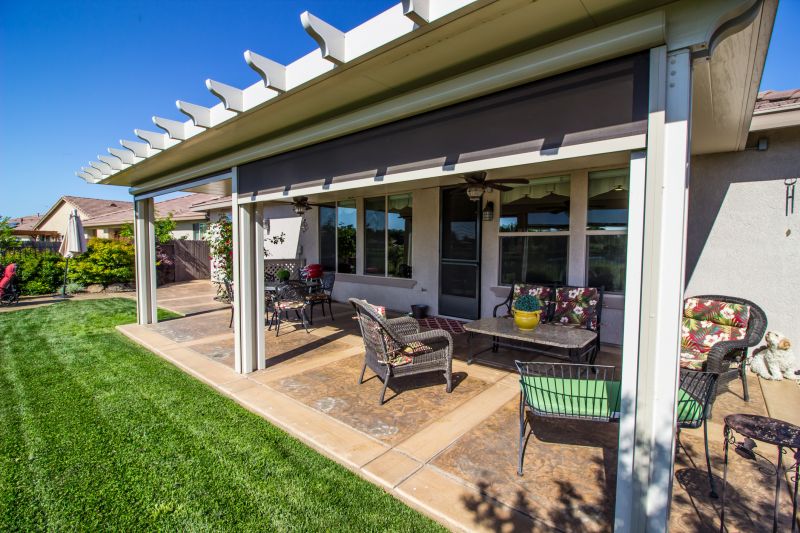Leading Product Selections For Stamped Patio Construction Enthusiasts
Equip yourself with top products that support efficient installation and beautiful, long-lasting stamped patios.
 Stamped patio constructions are a popular choice for enhancing outdoor living spaces with decorative concrete patterns that mimic the appearance of natural stone, brick, or slate. These patios provide a durable and versatile surface that can be customized to match various aesthetic preferences. The process involves pouring concrete and then imprinting patterns onto the surface using specialized stamps, creating a textured and visually appealing finish. Proper selection of products and materials is essential to achieve long-lasting, attractive results.
Stamped patio constructions are a popular choice for enhancing outdoor living spaces with decorative concrete patterns that mimic the appearance of natural stone, brick, or slate. These patios provide a durable and versatile surface that can be customized to match various aesthetic preferences. The process involves pouring concrete and then imprinting patterns onto the surface using specialized stamps, creating a textured and visually appealing finish. Proper selection of products and materials is essential to achieve long-lasting, attractive results.
Top Overall Option
Stamped Concrete Pattern Kit
A comprehensive stamped concrete pattern kit includes a variety of durable stamping mats, release agents, and colorants designed to work together for creating textured, patterned surfaces. These kits are suitable for both DIY enthusiasts and professional contractors, offering versatility and ease of use to achieve consistent, attractive results. Proper application of these products can help in creating a customized look that mimics natural stone, brick, or slate, enhancing the aesthetic appeal of outdoor patios.
Types of Products For Stamped Patio Constructions
Stamping Mats
Flexible mats with embossed patterns used to imprint textures onto poured concrete, available in various designs to mimic natural materials.
Release Agents
Powders or liquids applied to molds to prevent sticking and ensure clean impressions during stamping.
Color Hardners
Additives mixed into concrete to enhance color and surface durability, providing a more vibrant and lasting finish.
Integral Color
Color pigments added directly into the concrete mix to produce uniform coloration throughout the surface.
Surface Sealers
Protective coatings applied after stamping to enhance appearance and resist stains, weathering, and wear.
Acid Stains
Chemical stains that provide a variegated, natural look to concrete surfaces, often used for accenting stamped patterns.
Color Sprays
Spray-on colorants used to add accents or highlight stamped patterns for added depth and visual interest.
Texturing Tools
Additional tools such as trowels and brushes used to create unique surface textures and finishes.
Edge Restraints
Materials used to define the edges of the stamped area and provide structural support.
Joint Fillers
Materials used to fill expansion joints, preventing debris buildup and maintaining surface integrity.
Popular Choices
All-in-one kits containing mats, release agents, and colorants for creating patterned concrete surfaces.
Clear sealers that enhance the appearance of stamped concrete while providing a protective layer.
Powdered color additives that improve surface color and durability during concrete pouring.
Variety of stamps and mats designed for creating diverse textures and patterns on fresh concrete.
Lightweight powders applied to molds to facilitate clean impressions and prevent sticking.
Chemical stains used to add natural color variations and accents to stamped surfaces.
Wax-based sealers that add a glossy finish and extra protection to stamped concrete.
Tools for adding fine details or additional surface textures to stamped concrete.
Materials to define borders and support the stamped area for a clean finish.
Flexible sealants used to fill expansion joints and prevent debris accumulation.
To ensure a successful stamped patio project, it is important to consider the quality of the concrete mix, the type of stamping tools used, and the finishing techniques. High-quality concrete mixes with appropriate additives can improve durability and ease of stamping, while different stamp patterns and textures allow for a wide range of design options. Additionally, choosing the right sealers can enhance the appearance and provide protection against weathering and wear. Proper preparation, application, and maintenance are key to maintaining the beauty and integrity of the stamped surface over time.
Many homeowners and contractors opt for specialized tools and products designed specifically for stamped concrete projects. These include various stamping mats, release agents, colorants, and sealers that work together to produce a professional-looking finish. Understanding the differences between these products and how they interact can help in selecting the right combination for your project. Whether creating intricate patterns or simple textures, the right products can make a significant difference in the final outcome, ensuring the patio remains attractive and functional for years to come.
Investing in quality products for stamped patio construction can lead to more consistent results and easier application processes. From surface preparation to sealing, each stage benefits from the appropriate tools and materials. Properly selected products can also simplify maintenance routines, allowing for easier cleaning and touch-ups. Ultimately, choosing the right products tailored to your specific design goals and site conditions will help you create a stunning and durable outdoor space that enhances your property's appeal.
Key Buying Considerations
- Compatibility of products with existing concrete or substrate conditions.
- Durability and weather resistance of sealers and surface treatments.
- Variety and realism of stamp patterns to match your design vision.
- Ease of application, especially for DIY projects or professional use.
- Color options and the ability to achieve consistent hues throughout the surface.
- Compatibility of colorants and hardeners with the concrete mix for optimal results.
- Application timeframes and drying times for various products.
- Level of surface protection provided by sealers against stains and wear.
- Ease of maintenance and cleaning after installation.
- Price and availability of product kits versus individual components.
- Environmental conditions during application, such as temperature and humidity.
- Long-term performance and resistance to cracking or fading.
- Compatibility of products with other decorative concrete techniques if combined.
- Availability of technical support or instructions from suppliers.
- Compatibility with existing outdoor features and landscape elements.
